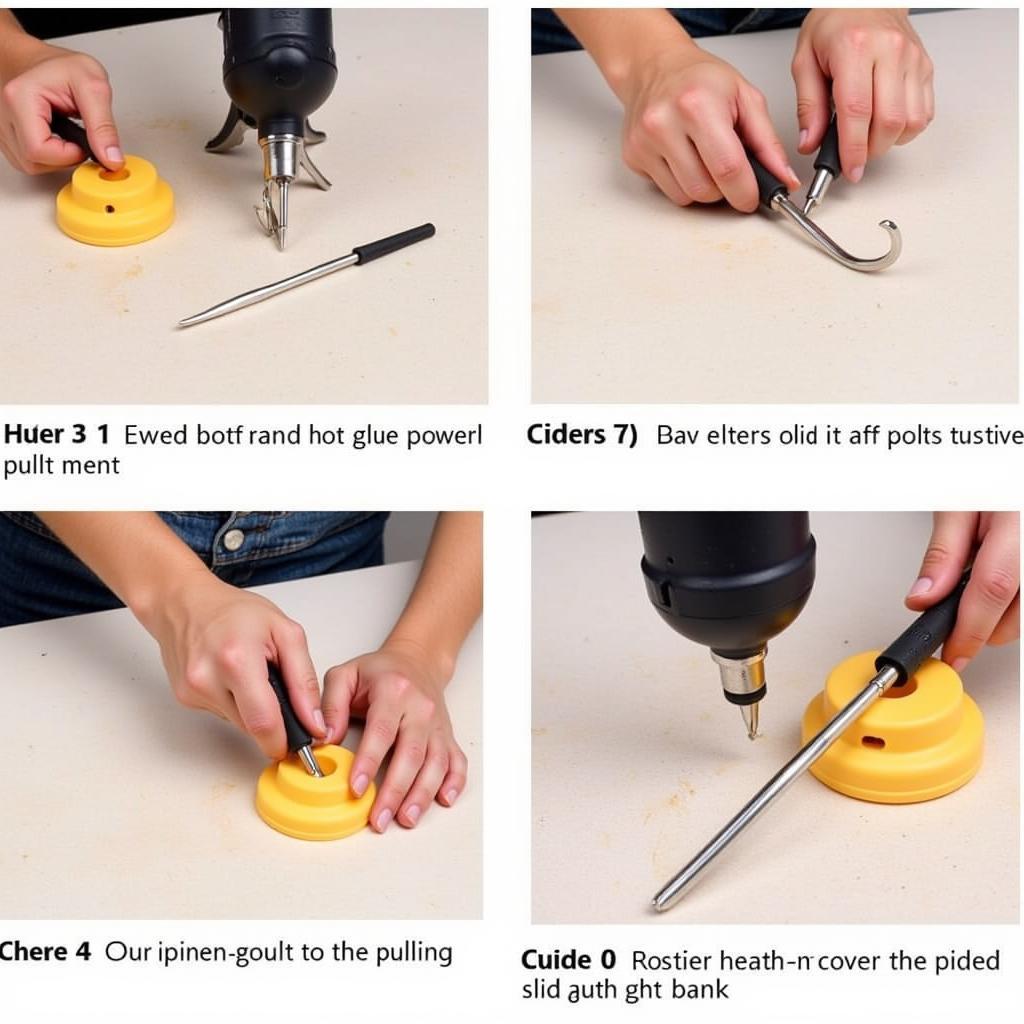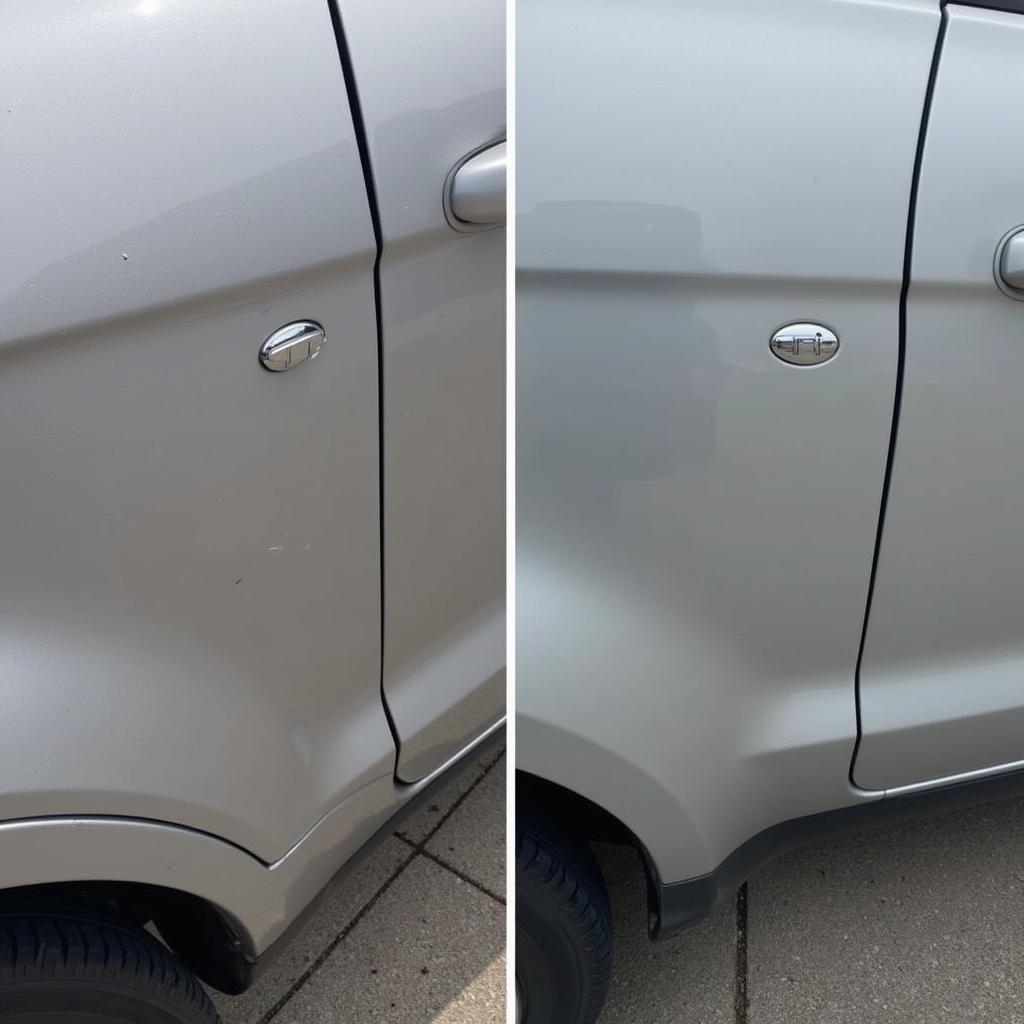Using Hot Glue To Fix Car Dents is a DIY method that has gained popularity online. But does it really work, or is it just another internet fad? This article dives deep into the hot glue dent removal technique, exploring its effectiveness, limitations, and providing expert advice to help you make informed decisions about your car repairs. Let’s explore fixing car dings.
Car dents are an unfortunate reality of vehicle ownership. Whether it’s a rogue shopping cart, a careless driver in a parking lot, or even a hail storm, the frustration of a dinged-up car is universal. While traditional dent repair methods can be costly, DIY solutions like the hot glue method have emerged, promising a cheaper and quicker fix. But before you grab your glue gun, it’s crucial to understand the nuances of this technique. You can also learn how to fix car dents yourself from other resources.
Understanding the Hot Glue Method for Car Dent Repair
The hot glue method involves applying hot glue to the dented area and then using a pulling device, such as a suction cup or slide hammer, to pull the dent out. The idea is that the glue adheres to the dent, providing a pulling point without damaging the paint. This seems simple enough, but several factors determine the success of this method.
Factors Influencing Hot Glue Dent Removal Success
- Dent Size and Depth: The hot glue method is generally more effective on small, shallow dents. Larger or deeper dents might require professional intervention. Trying to pull out a deep dent with hot glue may cause further damage to the car’s panel.
- Dent Location: Dents located on curved surfaces or near edges can be more challenging to fix using hot glue. The complex contours can make it difficult to achieve even pulling force.
- Type of Glue: Using high-quality hot glue designed for heavy-duty applications is crucial. Low-quality glue might not provide sufficient adhesion, leading to unsuccessful dent removal or even paint damage.
- Pulling Technique: Applying the right amount of pulling force is essential. Too little force won’t pull the dent out, while excessive force can damage the paint or worsen the dent.
 Hot Glue Dent Repair Process in Action
Hot Glue Dent Repair Process in Action
After the dent is pulled out, the glue needs to be carefully removed. This usually involves using a plastic scraper or a heat gun to soften the glue. If done improperly, the paint can be damaged during this process. For information on dent repair costs in Raleigh, NC, check out cost to fix dent in car raleigh nc.
Is Hot Glue Dent Repair Effective?
The hot glue method can be effective for minor dents, offering a quick and inexpensive DIY solution. However, it’s not a miracle cure for all types of dents. Realistic expectations are crucial. If you’re attempting to repair a large, deep, or complex dent, professional repair might be the best option.
When to Consider Professional Dent Repair
- Large or Deep Dents: These dents often require specialized tools and techniques that go beyond the scope of DIY repairs.
- Dents with Creases or Paint Damage: These types of damage usually require body filler and repainting, which are best handled by professionals.
- Dents on Complex Curves or Edges: These areas can be challenging to repair using the hot glue method and may require professional expertise.
- Valuable or Classic Cars: It’s always advisable to consult a professional for repairs on valuable or classic cars to avoid any potential damage.
 Professional Dent Repair Tools and Equipment
Professional Dent Repair Tools and Equipment
“The hot glue method is a useful tool for minor dents, but it’s important to be realistic about its limitations,” says John Smith, Automotive Engineer at Smith Auto Solutions. “Attempting to fix significant damage with hot glue can often lead to more problems.” You may find information on how to fix a dent in a car roof useful for specific dent locations.
Hot Glue Dent Repair: Step-by-Step Guide
If you decide to try the hot glue method, here’s a step-by-step guide to help you get started:
- Clean the Area: Thoroughly clean the dented area with soap and water, followed by a degreaser. This ensures proper adhesion of the hot glue.
- Apply the Glue: Apply a generous amount of high-quality hot glue to the center of the dent. Ensure the glue covers the entire dented area.
- Attach the Pulling Device: Quickly attach a suction cup or slide hammer to the glue before it cools and hardens.
- Pull the Dent: Gently and steadily pull the dent outwards. Avoid jerky movements, which can damage the paint.
- Remove the Glue: Once the dent is pulled out, carefully remove the glue using a plastic scraper or a heat gun. Apply heat gently to soften the glue before removing it.
 Removing Hot Glue from a Car’s Surface
Removing Hot Glue from a Car’s Surface
“Remember, patience is key when using the hot glue method,” advises Maria Garcia, Lead Technician at Garcia Auto Repair. “Take your time and avoid rushing the process.” Learn how to fix a dent on a car door for more specific instructions.
Conclusion
Hot glue can be a viable option for fixing minor car dents, offering a cost-effective DIY solution. However, it’s not a one-size-fits-all solution. Understanding the limitations of this method is crucial. For significant dents or those on complex surfaces, professional repair remains the best option. Remember to assess the dent carefully before attempting any DIY repairs. If you have any questions or concerns, feel free to contact us at AutoTipPro at +1 (641) 206-8880 or visit our office at 500 N St Mary’s St, San Antonio, TX 78205, United States.
 Comparing DIY and Professional Dent Repair Results
Comparing DIY and Professional Dent Repair Results
FAQ
- Can I use any type of hot glue for car dent repair? No, use high-quality, heavy-duty hot glue.
- Will the hot glue damage my car’s paint? It can if not removed carefully.
- What type of dents is the hot glue method best suited for? Small, shallow dents on flat surfaces.
- Is the hot glue method a permanent fix? It can be for minor dents, but professional repair is often more reliable.
- What should I do if the hot glue method doesn’t work? Consult a professional auto body repair shop.
- How long does the hot glue method take? It can take anywhere from 30 minutes to an hour, depending on the dent.
- What are the alternatives to the hot glue method for DIY dent repair? Other options include using a hair dryer and compressed air, or a dent puller kit.





Leave a Reply